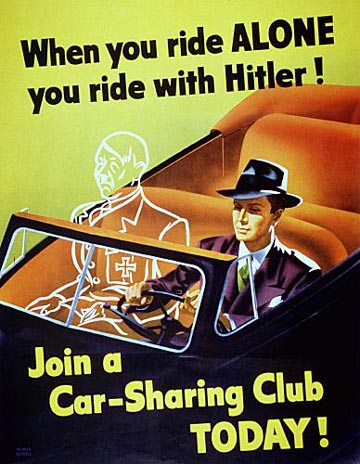Wavepacket Blog displaying only one specific post |
| 2009 | |
| May | |
| Thu May 21 23:02:43 2009 Fighting Traffic |
|
| >> links >> | |
| Thu May 21 23:02:43 2009 Fighting Traffic Why do cities persist with bad solutions? |
|
| I often think about traffic. Usually because I'm stuck in it.
I have a short but sometimes brutal commute to and from work. Typically it is 20 minutes, but occasionally I'll get stuck in stop-and-go traffic on the Interstate. And on the weekend I sometimes have to drive long distances, and again I'll run into traffic jams. Traffic isn't exactly a recent phenomenon. Julius Caeasar once banned carts during daylight in Rome because of the severe traffic. Today we have other methods of attempting to control or reduce traffic. There are HOV lanes, express lanes, and other ideas such as stoplights at on-ramps, and road pricing. I've found HOV lanes the most frustrating. Of course, I'm usually driving alone, so I could just be jealous. But I find that they are underused when there is very little traffic, so that most of the time they just reduce road capacity without adding any benefit. And when traffic does pick up, the HOV lanes are usually just as clogged as any other lane. There may be times when the HOV lanes are moving and other lanes aren't, but I rarely see that. Which means that most of the time, HOV lanes are ineffectual, and maybe cause more congestion than they relieve. It's possible that relieving congestion isn't the point. Perhaps HOV lanes are known to cause additional congestion, but are meant to reward carpoolers? But then I don't understand the motivation. It seems like we should only care about two things:
Express lanes seem to actually work. They add capacity to the highway when needed. And they are reasonably efficient, since cities can build for asymmetric traffic (rush hour in the morning is usually a different direction than rush hour in the evening). Stoplights at onramps also seem to work. You end up with traffic flowing smoothly into the interstate, instead of getting surges of cars that can then cause backups on the Interstate. When driving long distances, I definitely notice that unmetered onramps can cause a larger interruption to other drivers. Best of all, in my opinion, is road pricing. With road pricing, people pay money when they are in a traffic jam. (Or, depending on the city, they pay money if they are likely to be in a traffic jam, given when and where they are driving). Especially in the next few years, as we get to cars that will be more aware of other traffic in the city, the ability to charge people that are in congested areas will do the most to motivate people to change their habits, or think a bit further ahead before driving into congested areas. I've seen some arguments that road pricing isn't fair because it charges everyone the same rate. But that's just a problem with the pricing, not road pricing in general. A city could always charge based on the price of the car, for instance. Beyond traffic flow, the best fix for congestion is urban planning. I think urban planning is a misunderstood art. Central planning at large scales doesn't work--just ask the former Communist states. But by using game theory and more general economic strategies, urban planners can influence a complex system such as a city so that it optimizes for less congestion and emissions, without planning every last road. Comments |
Related: economics energy environment Unrelated: books geopolitics lists mathematics predictions science |
| Links: |  |
Blog Directory | Blog Blog | Technorati Profile | Strange Attractor |
